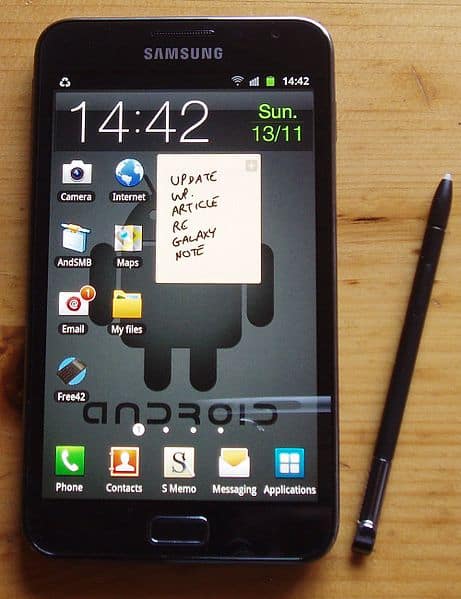Samsung electronics posted record quarterly profits of $5.15 billion driven mainly by its Galaxy Note phone+ tablet, when rivals criticized for its unstylish and obsolete stylus S and a mammoth screen size of 5.3 inch screen which was unheard of for a phone and which definitely needs a large palms to fit in.
The Styluses are Obsolete, but still Samsung Sold 5 Million Galaxy Note Units
When you think of the humble stylus, you may think of the Palm or Newton, innovative devices for their era, but the mid-’90s were centuries ago in tech years. The iPhone ushered in the Age of multi-touch, an era in which the stylus seems unnecessary and archaic.
Steve Jobs famously dismissed the stylus as a dead-end for tablet evolution, and Apple has been going in a different direction ever since. Even to the point of ignoring a significant demand from their customer base, and letting third-party developers (Apple’s classic blind spot) pick up the slack.[http://arstechnica.com/apple/reviews/2012/03/does–the–stylus–still–blow–it–on–the–new–ipad.ars]
Samsung (despite allegedly “slavishly copying” Apple in other areas) has made great strides in rehabilitating the stylus’ cutting-edge reputation. The Galaxy Note has done better than anyone expected, and some analysts are now saying that the mobile battle is squarely between the two companies.
Samsung has upped the ante with a Premium Suite upgrade to its already-desirable S Pen and S Note, and sweetened the pot by launching a campaign featuring everyone’s favorite time-waster, Angry Birds.
Stylus vs. Multitouch: What’s Best?
Multitouch Pros:
- Intuitive: if you can finger-paint, you can use multitouch. The learning curve is nearly flat; first-timers can anticipate maybe 30 seconds before they’re swiping and pinching like seasoned pros. Even the simplest stylus requires a bit of hands-on time to get the hang of it, and each different model of stylus typically offers its own quirks and functions.
- Multiple points of contact: a stylus has one point (maybe two, but you’ll need to flip it around first). Multitouch, by definition, starts with a minimum of two fingers, among other things, just try zooming with a stylus.
- No additional hardware: if you bring your fingers, you’ve got all of the tools for the job. It may not take much time to get the stylus out and ready, but that’s still an extra second or so. And that’s if you have it with you; as countless parents or gamer geeks can tell you, the Nintendo DS stylus spends a lot of time lost between the couch cushions, or simply lost, period.
Stylus Pros:
- Handwriting: Handwriting is more intuitive than typing; (almost) everyone knows how to do it already. Sure, many people can type faster than they can write, but the playing field levels when it comes to the smaller, less tactile onscreen keyboards of touchscreen devices. Toss in a decent handwriting recognition engine, and you have an input device that is fast, intuitive, and, unlike an onscreen keyboard, doesn’t take up half the screen. Or pair it with an optimized keyboard app such as Swype, and you may find yourself calling the marriage “genius.”
- Drawing: You can doodle with your fingers, but a stylus is simply more suited for everything from a quick diagram while taking notes, precise CAD or architectural drafting, or genuinely artistic sketching and drawing (for proof, just consider the perennial popularity of Wacom’s product lines).
- Precision: aside from the note-taking, handwriting, and drawing advantages, a stylus gives you the pixel-precise control of a mouse cursor on your mobile device. Among other things, this makes clicking buttons and links a much less hit-or-miss situation, especially on non-mobile-optimized sites. There are still far too many; including, shamefully, Apple and Android themselves.
These and other advantages make the stylus a natural fit for a 5″ – 7″ device (‘phablet’) such as the Galaxy Note 5.3, which splits the difference between the greater screen space of tablets and the more convenient mobility of a smartphone. The impressive debut of the “iPad killer” Kindle Fire, although it’s obviously a mutlitopuch device, still begs the question of whether the industry and consumers are eager for the right product to bridge the multitouch / stylus gap; potentially, replacing both extremes with a single device.
Surprisingly, voice calling on a larger device is not the deal-breaker that we usually assume it to be, and consumers have shown that they’re not resistant to using larger devices to make calls anyway.
Still, the 5.3″ Galaxy Note ‘phablet’ isn’t the only product eyeing the pen interface. Samsung also has the 10″ Galaxy Note 10.1 preparing for launch, while HTC (with the 7″ Flyer) and Lenovo (with the 10″ Thinkpad) have tested the waters with stylus-centered mobile hardware.
And, although Steve Jobs may be spinning in his grave, even Apple has quietly applied for their own stylus input patents in recent months.
What’s your take on stylus vs. multitouch input? Can both systems peacefully co-exist, or will one reign supreme? Let us know in the comments.
Sponsored by: CableTV.com, an authorized XFINITY Dealer.

